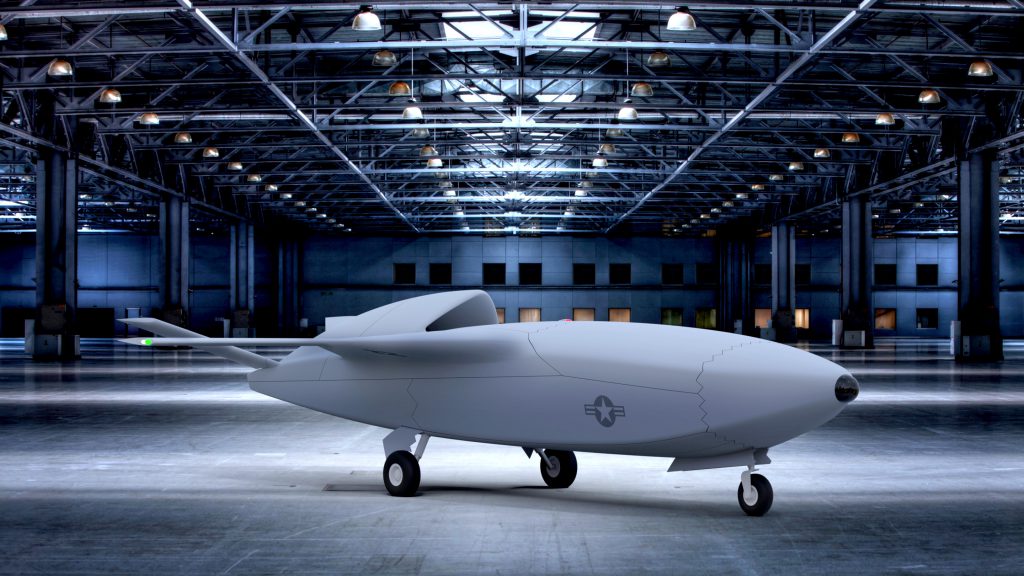Warfighting today, on a global scale, is an ever-evolving domain. Wars—specifically the ways in which they’re fought—continue to change under the influences of political climate, global economics, and technological innovations. Technology can influence the military sphere in countless ways, namely the bringing about of new offensive or defensive weapons that make neutralizing threats safer, more efficient, or both. Technological innovations in the combat domain are not limited to single weapons, however. In recent years, the United States Department of Defense has pushed for comprehensive solutions to problems that may arise in future conflicts with near peers, such as the rising capabilities of Russian and Chinese Air Forces. One such solution, proposed by Kratos Defense and Security Solutions for the USAF’s Skyborg program, is the XQ-58A Valkyrie unmanned aerial vehicle. The Valkyrie, like other military drones, is an unmanned weapon system capable of delivering a payload in a combat situation. Where the Valkyrie differs from its UAV counterparts, however, is its ability to “link up” to manned fighter aircraft via encrypted data links. The advent of new “loyal wingman” airframes will not only bring about a more technologically-advanced means of air superiority, it will effectively give rise to an entirely new set of warfighting tactics for the military at large.
The structure of today’s Air Force is quite different from what it’s been in years past. With just over 5,000 active-duty aircraft, today’s numbers pale in comparison to the 300,000+ aircraft in service during the Second World War. A significant reason for this disparity is the cost of modern-day aircraft. A state-of-the-art Lockheed Martin F-35 Joint Strike Fighter costs around $85 million, or roughly 115 times the cost of a P-51 fighter aircraft during World War II (adjusted for inflation). Though today’s military boasts a much smaller total force, the technological advancements in the airframes themselves have more than compensated for the numbers. Modern F-35, F-22, and F-16 airframes are faster, stealthier, and more maneuverable than aircraft of yesteryear could ever dream of, and hold impressive combat records to show for it. The shift from high quantity/low quality to low quantity/high quality is a trend that manifests itself in many military sectors, and one that has helped the United States remain successful in countless combat operations in the past few decades.
Today’s military leadership, however, has begun thinking long-term regarding future conflicts. In the War on Terror, Air Force engagements were primarily air-to-ground or air-to-air against lesser-trained combatants. The need for a high quantity of aircraft was unnecessary, as was the need to update older, out-of-date airframes. As the United States makes the transition from conflict in the Middle East to defense against near-peer adversaries, the capabilities of the USAF’s inventory might require updating. Modern Russian and Chinese surface-to-air (SAM) missile systems, such as the infamous S-400, are perhaps the most dangerous weapon Air Force and Navy pilots go up against. Missile systems are relatively inexpensive to produce, difficult to detect from the air, and nearly impossible to “shake off” once fired. SAM sites are a real threat to modern-day military aviators, accentuated by the incredibly high cost of Air Force and Navy aircraft. Relatively high losses of experienced pilots and expensive fighters have led military leadership to push towards an inexpensive “fleet-style” aircraft, one that could take heavy losses and protect both pilots’ lives and the expensive aircraft they operate.
“Skyborg” is an Air Force-sponsored program designed to do just this. According to the Air Force Research Laboratory (AFRL), “Skyborg is an autonomy-focused capability that will enable the Air Force to operate and sustain low-cost, teamed aircraft that can thwart adversaries with quick, decisive actions in contested environments. The program will enable airborne combat mass by building a transferable autonomy foundation for a family of layered, unmanned air vehicles.” Essentially, the Air Force wants to maximize the effectiveness of manned fighter aircraft by supplying them with R2-D2-esque robotic wingmen. Working with Kratos Defense and Security Solutions, the AFRL has developed the XQ-58A Valkyrie UAV, which is engineered to meet and exceed the specifications set by Air Force leadership.
The XQ-58A Valkyrie project aims at protecting manned pilots by keeping the pilots out of harm’s way in dangerous environments. The pilot would be able to communicate to the drone a variety of commands, such as to scout out a nearby area for SAM sites, perform reconnaissance, or provide the pilot with important data so that he or she may make a more informed decision. Additionally, the drones would be able to carry and deliver additional ammunition and payload, effectively multiplying the capabilities of the manned jet. Perhaps the most beneficial aspect of the Valkyrie project is its cost. At around $2 million each, the XQ-58A is an absolute bargain for the Air Force. Compared to the $85 million and $120 million price tags for the F-35 and RQ-4 UAV, respectively, the XQ-58A is a steal. The low cost of these “unmanned wingmen” will allow commanders to exercise more risk when sending them into combat zones, a privilege not available when dealing with manned systems.
As with any unmanned AI technology, there are those who propose the concept of robotic wingmen is dangerous. Opinions like this, heightened by pop-culture films like Robocop, Blade Runner, and Terminator, are unfortunately very prevalent among military and civilian leaders alike. Despite the AFRL’s repeated claim that real people will always be on the other end of lethal decision-making, whether or not our military should utilize autonomous weapons is still a hot topic. The XQ-58A, unlike the remotely-piloted aircraft (drones) currently in use by the USAF, would be fairly autonomous. This means it would take off itself, fly itself, and even “make decisions” by itself, guided by an extensive network of sensors and algorithms programmed in accordance with given rules of engagement. The pilot in command of the accompanying aircraft would have final say if the Valkyrie were to use a lethal weapon, but many general aerial operations would be completely autonomous. The Air Force’s Skyborg program, according to the AFRL, also has the responsibility of building trust in autonomous systems among leadership across all branches of the military. If the XQ-58A proves to be a success in its final stages of testing, the United States Army, Navy, and Marine Corps may begin instituting autonomous weapons in their operations to achieve combat victories more efficiently and safely.
Additionally, there are moral concerns that have been brought up. Similar to the remotely-piloted aircraft (drone) debates that have gone on for years, opponents of the Air Force’s Skyborg program claim that the concept of an autonomous system employing weapons based on AI algorithms is morally objectionable. Despite the efforts made by the AFRL to explain the limits of the autonomous functions, it may take time to convince even some seasoned military leaders. Additionally, another concern is the possibility for recklessness towards the drone on behalf of the pilot. When his or her life isn’t at stake, the pilot may be more inclined to send the drone into dangerous situations. While this is essentially what the XQ-58A was designed to do, it may lead to an apparent disconnect between the pilot and reality, and develop into a false sense of confidence.
Debates aside, the XQ-58A Valkyrie and the Air Force’s Skyborg program are without a doubt going to make a significant impact on the way wars are fought today, and in the future. The transition from a few highly-advanced and incredibly expensive airframes to many smaller, inexpensive ones is one that was seen once before (during the Second World War), and will once again make an impression on the current state of the Air Force. The new, 4th and 5th generation stealth fighters that make up today’s force aren’t going anywhere, but with the help of the XQ-58A robotic wingmen, their losses will be significantly reduced. As of late July, 2020, Kratos was awarded a five-year $400 million contract by the AFRL for the design and production of the XQ-58A Valkyrie, and work on the project will take place over the next 60 months.
Written By: Vincent J. Burke, University of Notre Dame, 2020 RPA Summer Intern



